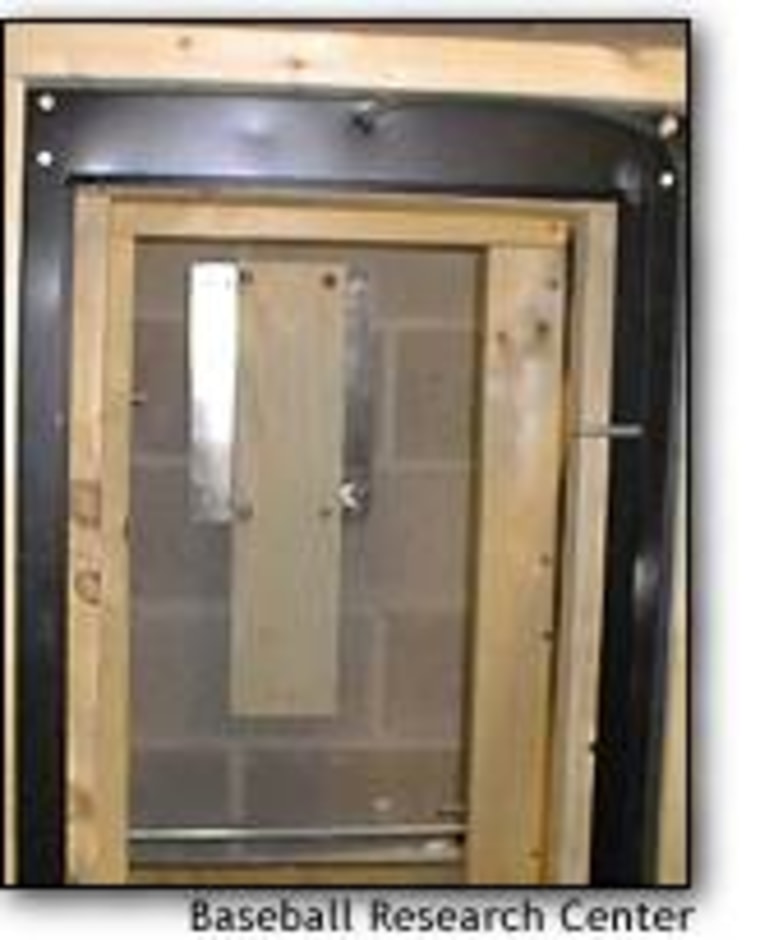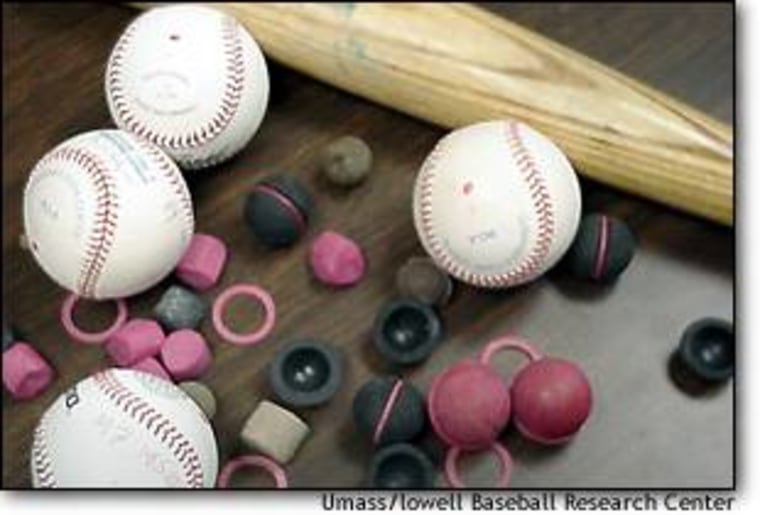It’s bombs away again this year in Major League Baseball. Home runs have been flying out of ballparks at a record rate. And to figure out whether the baseball has been “juiced” to produce more fan-pleasing homers, it’s been Baum’s-away at an engineering lab at the University of Massachusetts at Lowell.
Barry Bonds, Mark McGwire, Carlos Delgado and others have been mashing, smashing, and crushing baseballs in the name of RBIs. Dr. Jim Sherwood and his colleagues at the university have been destroying baseballs in the name of CORs.
The Coefficient of Restitution is a measure of how resilient the ball is - how bouncy it is. An official major league ball is supposed to have a COR between .514 and .578. If a batter can hit the ball 400 feet at the low end of the scale, the same batter should be able to hit the ball 49 feet farther at the top end of the scale.
The random sample of baseballs Sherwood tested averaged .55, toward the upper end of allowably “bouncy.” After reviewing the university’s findings, Major League Baseball said the tests verified that this year’s baseballs were in line with its specifications.
Baums away
To see how lively a baseball is, Sherwood puts the ball through a process that leaves it quite dead. And the end is neither swift, nor pretty. First, researchers shoot it out of a cannonlike device at 85 feet per second - about 60 mph - into a slab of northern white ash (the wood they make baseball bats out of) mounted on a wall. Measuring devices record the inbound speed of the ball just before it hits the wall, and the outbound speed just after.

The outbound speed divided by the inbound equals the Coefficient of Restitution. Each ball is shot against the slab of wood four to six times. The final COR for each ball is the average of all those shots. The final, final COR is the average of a dozen balls.
Then it’s time to Baum away, with the Baum Hitting Machine, an ingenious contraption that can swing a bat at any speed and angle the researchers want. Across the room from the hitting machine, the baseball is loaded into another cannonlike device. It’s set between the tines of what looks like a tuning fork so a nice full smooth section of the ball’s leather, with no seams, is face forward. Then the ball is propelled, holding device and all, at 70 mph (the speed of a slow major league curveball) toward the Baum machine.
The machine slams the bat into the ball with a swing speed of 90 mph, about average for a major leaguer. Using calculations nearly as complex as those underlying many arcane baseball statistics, Sherwood and his baseball torturers can tell how far the ball would have gone. Comparing this with last year’s measurements, and those from the year before, is another way to tell whether lively baseballs, or McGwire’s forearms, are responsible for all those home runs.
Rigorous specifications
Sherwood says the 2000 baseball behaves the way the 1999 and 1998 versions did. Standardized testing began in 1998. They’re collecting older balls to test, but they’re not sure how reliable the results will be, since time, humidity and use may have changed the older samples. (You can hang on to your Duffy Dyer foul ball from 1970. Sherwood says they have a good stash of oldies lined up.)
Like we said, the death of a baseball in Sherwood’s lab is slow, and ugly. Now the end is near. Having squeezed the whole ball as much as possible to see if it’s juiced, Sherwood and his team rip the baseballs into pieces, to see if all their internal measurements match specifications.
The rulebook specifications for the parts of a baseball are enough to make you yearn for the relative simplicity of such baseball statistics as total bases, [H 2B (2 x 3B) (3 x HR)] ... on-base percentage [(HBBHBP) / (ABBBHBPsacrifice flies)] ... or range factor (POA) (9) /# of defensive innings].
The core of a baseball is called the pill (now you know where those sayings come from, as in “slap that little pill” or “toss him the pill”).
The pill must weigh 0.85 ounces, give or take 0.05 ounces. It must be 1.375 inches in diameter, give or take 0.01 inches.
Its three sublayers have their own sub-specifications in the rulebook for weight, size, color and chemical composition. Sherwood checks them all. (By the way, the major-league ball has a compressed cork center, while the minor leaguers have to use a ball with regular cork. Sherwood says the major-league ball is about 3 percent more lively. Ken Griffey Jr. might be just another hacker down in Triple A.)
Then come four different “winds” of yarn. Each layer has its own specifications for how many subthreads in each thread, the proper percentage of wool (85 percent) and other fibers (15 percent), the humidity under which it is to be stored, and proper ratios for - I’m not kidding - grains per yard reeling, which has something to do with the density of the fiber.
Each layer has to be made of a certain color of wool. Sherwood has no idea if the color of the internal parts of a ball have anything to do with its performance, but he inspects the colors anyway.
The outer cover of a ball has to be a certain grain of cowhide, which has been tanned a certain way. The manufacturer, Rawlings, can use horsehide, but only with Major League Baseball’s permission.

A tightly controlled process
Are you getting the idea that the creation of a baseball is a very tightly controlled process? Sherwood says the COR is the same whether the ball is wrapped in cow or horse.
Finally of course, the finished ball is supposed to be a certain weight, 5.125 ounces give or take an eighth of an ounce, and a certain circumference, 9.125 inches, plus or minus an eighth of an inch. These specifications have held true since 1872.
According to the rules, “finished baseballs shall be measured using a steel tape in gradations of 1/16 of an inch with 2 pounds of tension applied to the tape. The circumference shall be determined by measuring twice over two seams and once over four seams, and thereafter averaging the three measurements.”
And you thought figuring out a pitcher’s earned run average was complicated.
By the time Sherwood is done making sure that all these exacting specifications have been met, the ball is not juiced. It’s not alive. It’s not even round. It’s in shreds. And he can tell whether all those home runs flying out of major-league parks are because the ball is more lively than it should be (it’s not), or whether the reasons (more likely) are that major league pitching is getting weaker, ballparks are getting smaller and the players are getting bigger and stronger.
David Ropeik is a longtime science journalist and currently serves as Director of Risk Communication at the Harvard Center for Risk Analysis.